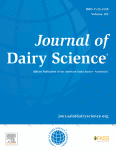Ver ítem
- xmlui.general.dspace_homeCentros e Institutos de InvestigaciónCICVyA. Centro de Investigación en Ciencias Veterinarias y AgronómicasInstituto de VirologíaArtículos científicosxmlui.ArtifactBrowser.ItemViewer.trail
- Inicio
- Centros e Institutos de Investigación
- CICVyA. Centro de Investigación en Ciencias Veterinarias y Agronómicas
- Instituto de Virología
- Artículos científicos
- Ver ítem
Expression-based analysis of genes related to single nucleotide polymorphism hits associated with bovine leukemia virus proviral load in Argentinean dairy cattle
Resumen
In dairy cattle infected with bovine leukemia virus (BLV), the proviral load (PVL) level is directly related to the viral transmission from infected animals to their healthy herdmates. Two contrasting phenotypic groups can be identified when assessing PVL in peripheral blood of infected cows. A large number of reports point to bovine genetic variants (single nucleotide polymorphisms) as one of the key determinants underlying PVL level. However, biological
[ver mas...]
In dairy cattle infected with bovine leukemia virus (BLV), the proviral load (PVL) level is directly related to the viral transmission from infected animals to their healthy herdmates. Two contrasting phenotypic groups can be identified when assessing PVL in peripheral blood of infected cows. A large number of reports point to bovine genetic variants (single nucleotide polymorphisms) as one of the key determinants underlying PVL level. However, biological mechanisms driving BLV PVL profiles and infection progression in cattle have not yet been elucidated. In this study, we evaluated whether a set of candidate genes affecting BLV PVL level according to whole genome association studies are differentially expressed in peripheral blood mononuclear cells derived from phenotypically contrasting groups of BLV-infected cows. During a 10-mo-long sampling scheme, 129 Holstein cows were phenotyped measuring anti-BLV antibody levels, PVL quantification, and white blood cell subpopulation counts. Finally, the expression of 8 genes (BOLA-DRB3, PRRC2A, ABT1, TNF, BAG6, BOLA-A, LY6G5B, and IER3) located within the bovine major histocompatibility complex region harboring whole genome association SNP hits was evaluated in 2 phenotypic groups: high PVL (n = 7) and low PVL (n = 8). The log2 initial fluorescence value (N0) transformed mean expression values for the ABT1 transcription factor were statistically different in high- and low-PVL groups, showing a higher expression of the ABT1 gene in low-PVL cows. The PRRC2A and IER3 genes had a significant positive (correlation coefficient = 0.61) and negative (correlation coefficient = −0.45) correlation with the lymphocyte counts, respectively. Additionally, the relationships between gene expression values and lymphocyte counts were modeled using linear regressions. Lymphocyte levels in infected cows were better explained (coefficient of determination = 0.56) when fitted a multiple linear regression model using both PRRC2A and IER3 expression values as independent variables. The present study showed evidence of differential gene expression between contrasting BLV infection phenotypes. These genes have not been previously related to BLV pathobiology. This valuable information represents a step forward in understanding the BLV biology and the immune response of naturally infected cows under a commercial milk production system. Efforts to elucidate biological mechanisms leading to BLV infection progression in cows are valuable for BLV control programs. Further studies integrating genotypic data, global transcriptome analysis, and BLV progression phenotypes are needed to better understand the BLV–host interaction.
[Cerrar]

Autor
Petersen, Marcos Iván;
Carignano, Hugo Adrian;
Suarez Archilla, Guillermo;
Caffaro, María Eugenia;
Alvarez, Irene;
Miretti, Marcos Mateo;
Trono, Karina Gabriela;
Fuente
Journal of Dairy Science 104 (2) : 1993-2007 (Febrero 2021)
Fecha
2021-02
Editorial
Elsevier
ISSN
0022-0302
1525-3198
1525-3198
Documentos Relacionados
Formato
pdf
Tipo de documento
artículo
Proyectos
(ver más)
INTA/2019-PD-E5-I102-001/2019-PD-E5-I102-001/AR./Desarrollo de vacunas y tecnologías para mejorar las estrategias profilácticas y terapéuticas de las enfermedades que afectan la producción animal y la salud pública
Palabras Claves
Derechos de acceso
Abierto
 Excepto donde se diga explicitamente, este item se publica bajo la siguiente descripción: Creative Commons Attribution-NonCommercial-ShareAlike 2.5 Unported (CC BY-NC-SA 2.5)
Excepto donde se diga explicitamente, este item se publica bajo la siguiente descripción: Creative Commons Attribution-NonCommercial-ShareAlike 2.5 Unported (CC BY-NC-SA 2.5)

